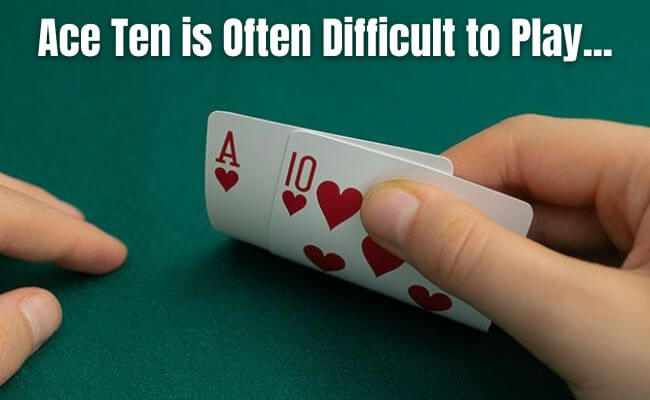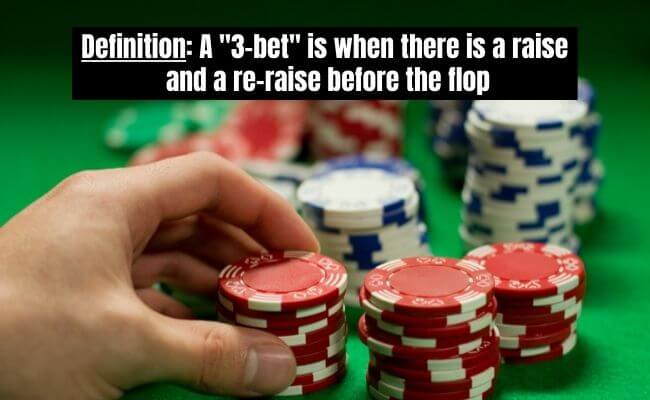This article was written by blackrain79.com contributor Fran Ferlan.
In no-limit hold’em, some hands are easier to play than others.
There are strong hands that basically play themselves, and there’s trash hands that you just fold preflop and you don’t think twice about it.
Between these two categories, there’s a wide range of hands that aren’t as straightforward, and can often be quite tricky to play.
This article will take a closer look at 5 hands a lot of players have trouble playing, why they’re so troublesome, and how to play them optimally.
1. Ace-Queen
Ace-Queen is one of the strongest starting hands in no-limit hold’em, yet a lot of players make a lot of costly mistakes with it.
One of the reasons for this is they tend to overvalue it in certain situations, and risk having only the second best hand.
As strong as Ace-Queen is, it’s still an underdog against other premium pocket pairs and Ace-King (suited or offsuit) from a hand equity perspective.
Here’s how Ace-Queen suited performs against other premium starting hands:
AQs vs AA : 13% equity
AQs vs KK : 32% equity
AQs vs QQ : 34% equity
AQs vs JJ : 46% equity
AQs vs AK : 30% equity
As you can see, with the exception of pocket Jacks, Ace-Queen is in bad shape against other premium hands, because it’s often dominated by them.
A dominated hand is the one that’s unlikely to win against another hand, due to the weaker kicker. For example, if you have Ace-Queen, and your opponent has Ace-King, your hand is dominated.
You always want your hand to dominate your opponent’s hand, instead of the other way around.
Ace-Queen does dominate a lot of hands, namely other Ax or Qx hands, and it will be one of your big long term winning hands.
However, the problem is that if you overvalue it, you will often run into hands that have you beat, which can cause you to lose a huge pot.
As the saying goes, the worst hand in poker is the second best hand.
And that’s precisely the problem with Ace-Queen. It’s too strong to let go of, but can often be more trouble than it’s worth.
This is especially the case if you get into a raising war preflop. Ace-Queen is a strong hand, and you should usually play it aggressively preflop.
This means open-raising and 3-betting preflop most of the time, since you can get action by a lot of weaker hands.
A 3-bet preflop is re-raise against another player’s open-raise.
However, if you encounter a 3-bet yourself, you should exercise more caution.
4-betting (i.e. re-raising against another player’s 3-bet) with Ace-Queen is probably not the most +EV play, since you aren’t likely to get action by any weaker hands.
You also can’t 4-bet as a bluff, because you aren’t likely to get stronger hands than yours to fold.
For more advanced strategies like light 4-betting, check out the Microstakes Playbook.
This leaves you the option of either folding or just flat calling the 3-bet. Folding is usually too nitty, unless you’re certain your opponent’s 3-betting range consists exclusively of premium starting hands that have you beat.
However, you can 4-bet with Ace-Queen if you’re up against a very loose and/or weak player, who can give you action with weaker hands, namely other Ax or Qx hands like KQ, AJ, AT etc.
Against more skilled players, on the other hand, more caution is advised, both preflop and postflop, as you aren’t likely to get action by a lot of hands you’re actually ahead of.
Check out Nathan’s recent video on starting poker hands you’re probably overvaluing.
2. Pocket Jacks
Pocket Jacks are a premium poker hand, and will be one of your biggest long term winners. However, a lot of players have trouble with playing this hand.
Some players even seem to hate and outright avoid playing pocket Jacks, because they have a feeling they always seem to lose with them.
It’s true that pocket Jacks can be a tricky hand to play, especially when you don’t flop an overpair.
An overpair is a pocket pair that’s stronger than the strongest possible pair on the board.
For example, on a board like: Q♥8♣5♥...
Pocket Aces and pocket Kings are an overpair.
Pocket Jacks are tricky because they won’t flop an overpair as often as other premium pocket pairs.
Pocket Jacks will make an overpair on the flop only 43% of the time.
Any Ace, King, or Queen on the board threatens to make your pocket Jacks only the second pair.
Even if you do flop an overpair with pocket Jacks, there’s still 12 possible outs your opponent can theoretically have to outdraw you on consecutive streets.
However, as troublesome pocket Jacks may be, they’re still a premium hand, and should be played as such.

This means playing it aggressively, especially preflop, when your hand is likely to be ahead of your opponent’s range.

This means playing it aggressively, especially preflop, when your hand is likely to be ahead of your opponent’s range.
Pocket Jacks are a slight favourite even against Ace-King suited, the strongest drawing hand in no-limit hold’em.
Pocket Jacks have roughly 54% hand equity against Ace-King suited.
This is not a huge margin by any means, but this means that pocket Jacks will be a winning hand for you more often than not.
But only if you play it right, and avoid some common pitfalls, namely playing pocket Jacks too passively.
If you don’t play pocket Jacks fast enough, you’re running the risk of your opponent outdrawing you. If your opponent wants to outdraw you, you should charge them a premium for doing so.
Don’t let them realize their hand equity for cheap. Let them know that if they want to get involved in a pot with you, especially with speculative hand, it’s going to cost them.
Check out my recent article on how to play pocket Jacks optimally for a more detailed analysis of this hand.
Learn Exactly What Hands to Play (Free Charts)
This is the best completely free poker strategy guide available online today. It shows you how to crush the small stakes games step by step.
Learn exactly what hands to play and when to bet, raise and bluff all in!
These are the proven strategies that I have used as a 10+ year poker pro to create some of the highest winnings of all time in these games.
Enter your details below and I will send my free poker "cheat sheet" to your inbox right now.
3. Small Pocket Pairs (Pocket Twos to Pocket Sixes)
Small pocket pairs may be pretty enough at a glance, but they’re actually not profitable long term winners.
That’s because small pocket pairs have very poor playability postflop unless they manage to hit a set.
Unfortunately, it’s very hard to flop a set with a pocket pair. So if you don’t flop a set, you will often just be forced to fold small pocket pairs post flop.
The chance of flopping a set or a stronger hand with a pocket pair is only about 12%.
This means that you’ll be losing money with small pocket pairs almost 9 out of 10 times.
If you don’t hit a set on the flop with a baby pocket pair, you will only have a third or fourth pair on the flop.
Your future prospects in the hand aren’t great, either.

You only have two outs in the deck left to improve to a set, and any other card threatens to make your hand even weaker, so by the river you might only hold a fifth or even a sixth pair.

You only have two outs in the deck left to improve to a set, and any other card threatens to make your hand even weaker, so by the river you might only hold a fifth or even a sixth pair.
An out is the card that you need to improve to a certain hand combination. The more outs you have, the stronger your draw.
If you don’t flop a set with a small pocket pair, you only have about 8% chance of improvement to a set from flop to river.
By the way, you can quickly calculate the chance of your hand improving by using the so-called rule of fours.
Rule of fours: you simply multiply the number of outs you have by 4 to get a rough percentage chance of your hand improving on turn or river.
For example, if you have a flush draw with 9 outs, you multiply 9 x 4. So your chance of improving to a flush from flop to river is roughly 36%.
If you want to calculate the chance of improving on just one street (turn to river, for example), you just multiply the number of outs by 2 instead of 4.
For more info on poker math and odds, check out my ultimate poker odds cheat sheet.
With all this in mind, baby pocket pairs have very limited playability unless they hit a set.
They also have very poor showdown value, as basically any other card threatens to make your hand relatively weaker.
Hands with showdown value are the ones that aren’t strong enough to value bet with (i.e. you can’t get called by weaker hands), but can often win the pot unimproved at showdown.
The more showdown value your hand has, the closer it comes to be a potential value betting candidate.
So all in all, baby pocket pairs are a very hit-or-miss type of hand. If you manage to hit a set, you can often win a huge pot, but if you don’t, you’ll often just need to give up the hand altogether.
Small pocket pairs are speculative hands that perform best with deep effective stack sizes, because you want it to be worth your while to try to hit your set post flop.
Playing small pocket pairs with the sole intention of hitting a set post flop is called set mining, and it can be very profitable if done correctly.
But set mining with any pocket pair regardless of the situation will just cause you to bleed money over the long run, since you won’t hit your set nearly as often as you might hope for.
Check out Nathan’s article on how to set mine profitably for more info on the topic.
4. Ace-Ten Offsuit
Ace-Ten offsuit is not a bad hand per se, but suffers a lot of similar problems like other hands on this list, namely the fact that it will often be dominated by stronger Ax hands, and overvaluing it is a recipe for disaster.
You should be extra careful with playing this hand from early positions at the table.
The earlier your table position, the stronger your hand needs to be to play it profitably, since there’s more players behind you that can potentially have a stronger hand than you.
This is where people usually get in trouble with a hand like A♥T♠
While you can play it profitably from later positions at the table (namely the cutoff and the button), that’s not always the case with early positions, (like under the gun, for example).
If you encounter a 3-bet, for example, you’ll be put in an awkward spot where you often can’t continue playing profitably, because your hand will often be dominated by stronger Ax hands like AK, AQ or AJ.

If your opponent has a lot of bluffs in their 3-betting range that your hand is ahead of, you can probably justify calling the 3-bet, but you’ll often find yourself in a marginal spot post flop, especially if you’re playing out of position.

If your opponent has a lot of bluffs in their 3-betting range that your hand is ahead of, you can probably justify calling the 3-bet, but you’ll often find yourself in a marginal spot post flop, especially if you’re playing out of position.
If you're having trouble with playing out of position, check out Modern Small Stakes.
Even if you hit an Ace on the flop, you often won’t be able to get a ton of value, since single pair hands are vulnerable to getting outdrawn.
Another problem with a hand like ATo is the fact that it doesn’t have the same nuts potential as suited Aces, for example.
One thing that Ace-Ten offsuit does have going for it is the ability to make the nuts straight. But the problem is that you won’t hit that straight nearly as often as you would with hands that are more connected (like AK or JT, for example).
One thing that Ace-Ten offsuit does have going for it is the ability to make the nuts straight. But the problem is that you won’t hit that straight nearly as often as you would with hands that are more connected (like AK or JT, for example).
The further apart your hole cards are, the harder it is to hit a straight.
For example, a hand like Jack-Ten can make four possible straight combinations, whereas Ace-Ten can only make a single straight combination.
Check out my recent article on how to play straight draws for more info on the topic.
5. Queen-Jack Offsuit
A lot of amateur poker players tend to overvalue certain broadway hands like QJo, which often leads them to a lot of sticky situations post flop.
Broadway hands are hands that can make the strongest possible straight.
The problem with a hand like Queen-Jack offsuit in particular is the fact that it will often be dominated by stronger broadway hands, like AQ, KQ, AJ or KJ.
This is especially the case in 3-bet pots, where you can expect a significant part of your opponent’s range to dominate your hand, so you’re running the risk of having only the second best hand.

Queen-Jack offsuit is also troublesome because it doesn’t have as much nuts potential as other suited broadway hands, which can make strong flushes.

Queen-Jack offsuit is also troublesome because it doesn’t have as much nuts potential as other suited broadway hands, which can make strong flushes.
Even if you have Queen-Jack suited, you’re still running the risk of your opponent having an even stronger flush, as all other Ax and Kx hands can potentially have you beat.
Queen-Jack has decent playability post flop, but you often won’t be able to play for a huge pot with it, as there’s a bunch of ways your hand can be dominated, whether you make a one-pair hand, a straight, or even a flush.
That’s not to say you should ditch this hand altogether, but you should be aware that there’s a bunch of hands that potentially have you beat.
As mentioned, you always want your hand to dominate your opponent’s, instead of the other way around.
You can still play Queen-Jack profitably, especially from the late position, namely the cutoff and the button.
But if you encounter a 3-bet, you should be aware that there simply aren’t too many hands in your opponent’s 3-betting range that you’re ahead of.
Playing Queen-Jack in a 3-bet pot can be even more costly if you’re playing it out of position.
Not only will your hand often be dominated, but you’ll also be playing the rest of the hand without the positional advantage.
This is discussed in much more detail in Crushing the Microstakes.
For this reason, it’s better to plan the hand ahead and avoid marginal situations altogether, especially with an easily dominated hand.
You want to play the majority of your hands in position as the preflop aggressor, as this is a proven way to give yourself a significant edge over your opponents.
If you're having trouble playing in 3-bet pots, enroll in Blackrain79 Elite Poker University.
You will learn a step-by-step process to dominate in 3-bet pots, by mastering advanced poker strategies like light 3-betting and light 4 betting.
Learning the advanced poker strategies is absolutely crucial in today's highly competitive games, where just waiting around for a huge hand isn't enough to be a proftitable long term winner.
By mastering the art of the light 3-bet, you'll be able to win "more than your fair share", regardless of the cards you're being dealt.
This is in addition to 17 hours of advanced poker training, hundreds of step by step example hands and downloadable "cheat sheets" below all 50 videos.
If you are serious about taking your poker game to the next level, enroll today.
Get $100 OFF Use Code: ELITE100
5 Poker Hands Everybody Screws Up - Final Thoughts
None of the hands on this list are bad hands per se, and most of them will actually be very profitable over the long run. Still, they can be quite tricky to play in a lot of situations.
This doesn’t mean you should avoid playing them altogether, of course. You just need to be aware of some common mistakes players make when playing them.
Avoiding mistakes and exploiting your opponent’s mistakes is the cornerstone of the tried and true winning poker strategy.
One of the things to keep in mind is how often your hand can be dominated by stronger hands. If you suspect your hand will often be dominated, it’s often better to just ditch it altogether and save your money.
Another thing to keep in mind is how certain hand categories perform post flop on different board textures. Some hands have way more post flop playability than others.
The bottom line is, you should always plan ahead to avoid getting stuck in a lot of marginal spots where you’re not sure what to do.
In other words, winning poker is all about playing proactively.
So always plan ahead, prepare for the worst, and hope for the best.
Lastly, if you want to know the complete strategy I use to make $1000+ per month in small stakes games, get a copy of my free poker cheat sheet.
.jpg)

